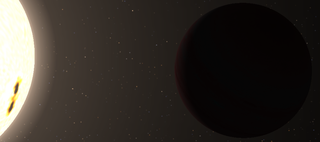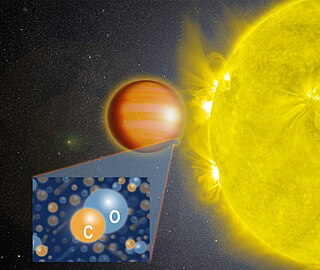Related Research Articles

HD 189733 b is an exoplanet in the constellation of Vulpecula approximately 64.5 light-years away from the Solar System. Astronomers in France discovered the planet orbiting the star HD 189733 on October 5, 2005, by observing its transit across the star's face. With a mass 11.2% higher than that of Jupiter and a radius 11.4% greater, HD 189733 b orbits its host star once every 2.2 days at an orbital speed of 152.0 kilometers per second, making it a hot Jupiter with poor prospects for extraterrestrial life.
HD 43691 is a star with an orbiting exoplanet in the constellation Auriga. With an apparent visual magnitude of 8.03, it is too faint to be visible to the naked eye. This system is located at a distance of 279 light years based on parallax measurements, but is drifting closer with a heliocentric radial velocity of −29 km/s.
WASP-2 is a binary star system in the Delphinus constellation located about 500 light-years away. The primary is magnitude 12 orange dwarf star, orbited by red dwarf star on wide orbit. The star system shows an infrared excess noise of unknown origin.

WASP-4b is an exoplanet, specifically a hot Jupiter, approximately 891 light-years away in the constellation of Phoenix.

WASP-8b is an exoplanet orbiting the star WASP-8A in the constellation of Sculptor. The star is similar to the Sun and forms a binary star with a red dwarf star (WASP-8B) of half the Sun's mass that orbits WASP-8A 4.5 arcseconds away. The system is 294 light-years away and is therefore located closer to Earth than many other star systems that are known to feature planets similar to WASP-8b. The planet and its parent star were discovered in the SuperWASP batch -6b to -15b. On 1 April 2008, Dr. Don Pollacco of Queen's University Belfast announced them at the RAS National Astronomy Meeting.

WASP-8 is a binary star system 294 light-years away. The star system is much younger than the Sun at 300 million to 1.2 billion years age, and is heavily enriched in heavy elements, having nearly twice the concentration of iron compared to the Sun.
WASP-11/HAT-P-10 is a binary star. It is a primary main-sequence orange dwarf star. Secondary is M-dwarf with a projected separation of 42 AU. The system is located about 424 light-years away in the constellation Aries.

WASP-4 is a G-type main-sequence star approximately 891 light-years away in the constellation of Phoenix. Despite its advanced age, the star is rotating rapidly, being spun up by the tides raised by a giant planet on a close orbit.
WASP-5 is a magnitude 12 G-type main-sequence star located about 1,020 light-years away in the Phoenix constellation. The star is likely older than the Sun, slightly enriched in heavy elements and is rotating rapidly, being spun up by the tides raised by the giant planet on a close orbit.
HAT-P-4 is a wide binary star consisting of a pair of G-type main-sequence stars in the constellation of Boötes. It is also designated BD+36°2593.
HAT-P-8 is a magnitude 10 star located 700 light-years away in Pegasus. It is a F-type star about 28% more massive than the Sun. Two red dwarf companions have been detected around HAT-P-8. The first has a spectral type of M5V and has a mass of 0.22 M☉. The second is even less massive, at 0.18 M☉, and its spectral type is M6V.
WASP-17 is an F-type main sequence star approximately 1,300 light-years away in the constellation Scorpius.

WASP-18b is an exoplanet that is notable for having an orbital period of less than one day. It has a mass equal to 10 Jupiter masses, just below the boundary line between planets and brown dwarfs. Due to tidal deceleration, it is expected to spiral toward and eventually merge with its host star, WASP-18, in less than a million years. The planet is approximately 3.1 million km from its star, which is about 400 light-years from Earth. A team led by Coel Hellier, a professor of astrophysics at Keele University in England, discovered the exoplanet in 2009.
WASP-19, formally named Wattle, is a magnitude 12.3 star about 869 light-years away, located in the Vela constellation of the southern hemisphere. This star has been found to host a transiting hot Jupiter-type planet in tight orbit.

HAT-P-14b, officially named Sissi also known as WASP-27b, is an extrasolar planet located approximately 224.2 ± 0.6 parsecs (731.2 ± 2.0 ly) away in the constellation of Hercules, orbiting the 10th magnitude F-type main-sequence star HAT-P-14. This planet was discovered in 2010 by the HATNet Project using the transit method. It was independently detected by the SuperWASP project.

HD 15082 is a star located roughly 399 light years away in the northern constellation of Andromeda. The star is a Delta Scuti variable and a planetary transit variable. A hot Jupiter type extrasolar planet, named WASP-33b or HD 15082b, orbits this star with an orbital period of 1.22 days. It is the first Delta Scuti variable known to host a planet.
WASP-33b is an extrasolar planet orbiting the star HD 15082. It was the first planet discovered to orbit a Delta Scuti variable star. With a semimajor axis of 0.026 AU and a mass likely greater than Jupiter's, it belongs to the hot Jupiter class of planets.
HAT-P-24 is an F8 dwarf star about 400 parsecs away. A planet was discovered with the transit method by the HATNet Project in 2010. HAT-P-24b, is a typical hot Jupiter orbiting in only 3 days.
HAT-P-17 is a K-type main-sequence star about 92.6 parsecs (302 ly) away. It has a mass of about 0.857 ± 0.039 M☉. It is the host of two planets, HAT-P-17b and HAT-P-17c, both discovered in 2010. A search for a binary companion star using adaptive optics at the MMT Observatory was negative. A candidate companion was detected by a spectroscopic search of high-resolution K band infrared spectra taken at the Keck observatory.
HD 146389, is a star with a yellow-white hue in the northern constellation of Hercules. The star was given the formal name Irena by the International Astronomical Union in January 2020. It is invisible to the naked eye with an apparent visual magnitude of 9.4 The star is located at a distance of approximately 446 light years from the Sun based on parallax, but is drifting closer with a radial velocity of −9 km/s. The star is known to host one exoplanet, designated WASP-38b or formally named 'Iztok'.
References
- 1 2 "WASP-18b". Exoplanet Transit Database. Retrieved 2009-08-29.
- 1 2 3 4 5 6 Vallenari, A.; et al. (Gaia collaboration) (2023). "Gaia Data Release 3. Summary of the content and survey properties". Astronomy and Astrophysics. 674: A1. arXiv: 2208.00211 . Bibcode:2023A&A...674A...1G. doi: 10.1051/0004-6361/202243940 . S2CID 244398875. Gaia DR3 record for this source at VizieR.
- ↑ Maxted, P. F. L.; et al. (2011). "UBV(RI)C photometry of transiting planet hosting stars". Monthly Notices of the Royal Astronomical Society. 418 (2): 1039–1042. arXiv: 1108.0349 . Bibcode:2011MNRAS.418.1039M. doi:10.1111/j.1365-2966.2011.19554.x. S2CID 117056033.
- 1 2 Hellier, Coel; et al. (2009). "An orbital period of 0.94days for the hot-Jupiter planet WASP-18b" (PDF). Nature. 460 (7259): 1098–1100. Bibcode:2009Natur.460.1098H. doi:10.1038/nature08245. hdl:2268/28276. PMID 19713926. S2CID 205217669.
- 1 2 Csizmadia, Sz.; Hellard, H.; Smith, A. M. S. (March 2019). "An estimate of the k2 Love number of WASP-18Ab from its radial velocity measurements". Astronomy & Astrophysics . 623: A45. arXiv: 1812.04463 . Bibcode:2019A&A...623A..45C. doi:10.1051/0004-6361/201834376. S2CID 119387925.
- 1 2 3 4 Cortés-Zuleta, Pía; Rojo, Patricio; et al. (April 2020). "TraMoS. V. Updated ephemeris and multi-epoch monitoring of the hot Jupiters WASP-18Ab, WASP-19b, and WASP-77Ab". Astronomy & Astrophysics . 636: A98. arXiv: 2001.11112 . Bibcode:2020A&A...636A..98C. doi:10.1051/0004-6361/201936279. S2CID 241596186.
- ↑ Torres, Guillermo; et al. (2012). "Improved Spectroscopic Parameters for Transiting Planet Hosts". The Astrophysical Journal. 757 (2). 161. arXiv: 1208.1268 . Bibcode:2012ApJ...757..161T. doi:10.1088/0004-637X/757/2/161. S2CID 16580774.
- ↑ "WASP-18". SIMBAD . Centre de données astronomiques de Strasbourg . Retrieved 5 November 2023.
- ↑ Polanski, Alex S.; Crossfield, Ian J. M.; Howard, Andrew W.; Isaacson, Howard; Rice, Malena (2022), "Chemical Abundances for 25 JWST Exoplanet Host Stars with KeckSpec", Research Notes of the American Astronomical Society, 6 (8): 155, arXiv: 2207.13662 , Bibcode:2022RNAAS...6..155P, doi: 10.3847/2515-5172/ac8676
- ↑ Pillitteri, I.; et al. (July 2014). "No X-rays from WASP-18. Implications for its age, activity, and the influence of its massive hot Jupiter". Astronomy & Astrophysics. 567: A128. arXiv: 1406.2620 . Bibcode:2014A&A...567A.128P. doi:10.1051/0004-6361/201423579. S2CID 118527777.
- ↑ "NASA's Chandra X-ray Observatory Finds Planet That Makes Star Act Deceptively Old". Chandra X-ray Observatory. Retrieved 20 September 2014.
- ↑ Pearson, Kyle A. (December 2019). "A Search for Multiplanet Systems with TESS Using a Bayesian N-body Retrieval and Machine Learning". The Astronomical Journal . 158 (6): 243. arXiv: 1907.03377 . Bibcode:2019AJ....158..243P. doi: 10.3847/1538-3881/ab4e1c . S2CID 195833716.